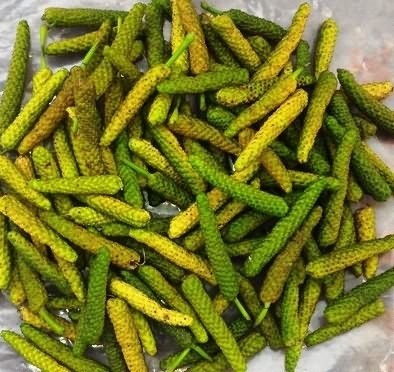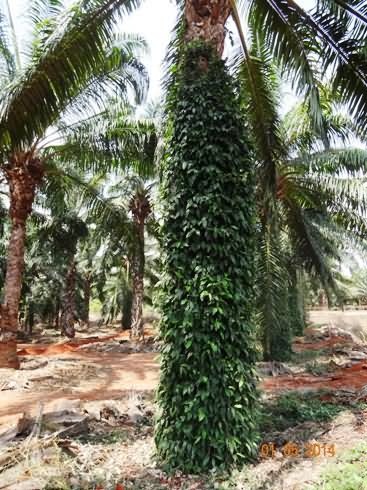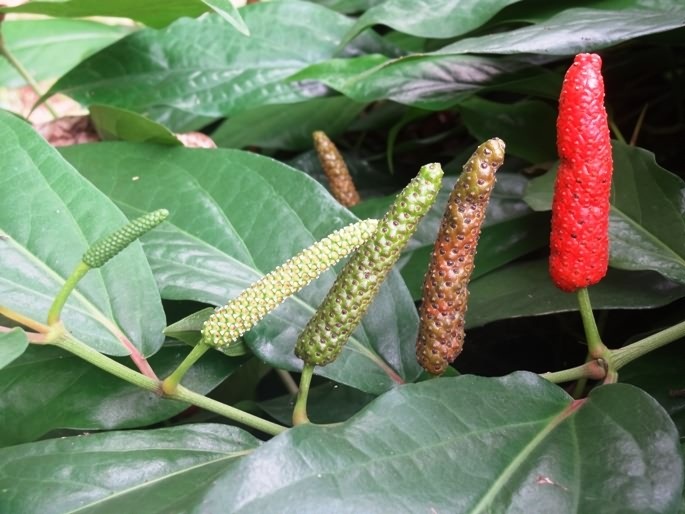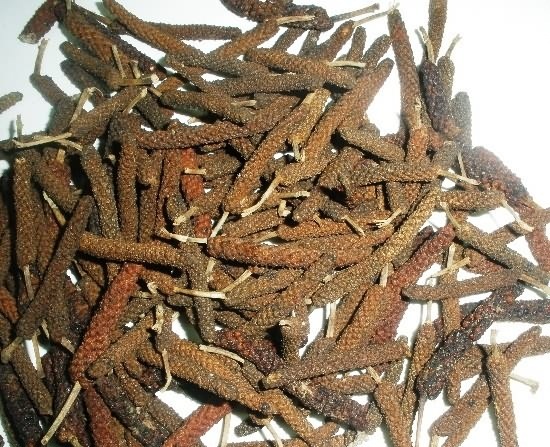पिपली: तेल खजूर के बडे बागानों के लिए आर्दश अंत:फसल
Java long pepper (Piper chaba Hunter syn. Piper retrofractum Vahl.) is one among Panchakola group of spices. Its fruits and roots are used in preparation of ayurvedic medicines for treating indigestion, abdominal colic, poisoning, haemorrhoids, anorexia etc.
It is native of South and South East Asia and commonly seen in Assam, Tripura and West Bengal in India. Because of medicinal and aromatic properties, its commercial production is picking up as an inter crop in coconut, areca nut and oil palm gardens in South India.
It is perennial with climbing growth habit and performing satisfactorily even under dense shade (75%) of oil palm. Cultivation of long pepper in grown up oil palm gardens is slowly picking up and its area is about 3000 acres in Andhra Pradesh and Telangana states.
 पिपली के फल
पिपली के फल
Botany Java long pepper
Java long pepper belongs to family Piperaceae. It is short knarled perennial in nature, glabbrous, fleshy climber with adhesive roots. Leaves are stalked, alternate, lanceolate on the vine and chordate on runners. Inflorescence is pedunculate flower spike that comes from main stem node opposite to leaf.
It flowers and bears fruits round the year. The fruit is drupe which is light green in colour when it is matured, red when ripened and turn black when it is dried.
Flowers are greenish yellow in colour and arranged spirally along the spine. Fruit contains 0.99% aromatic oil, 2-3% piperin and 8.8% alcohol. Roots contain 0.15-0.18% piperin and 0.13-0.20% piplartin.

Java long pepper is a tropical plant which requires hot and moist places and thrives well under heavy rainfall areas with high relative humidity. An elevation of 100-1000m above mean sea level (MSL) is ideal. It is found as under grown plant in natural habitat-tropical rain forest.
It requires partial shade of 25-30% for its best growth and development. It has been identified as one of the ideal inter crops in coconut and areca nut gardens in South India. Fertile and well drained forest and loamy soils are ideal for long pepper. It can also come up well in lateritic soil, red soil and light clay soil rich in organic matter and good water holding capacity.
Propagation and planting
Java long pepper is propagated by stem cuttings from runners. Cuttings with 3-5 nodes can be planted either in raised nursery bed or poly bags filled with potting mixture of soil and organic manure in 2:1 ratio. Rooting will start within 15 days and cuttings will get ready for planting in farmers garden by 2 months. In rainy season, farmers can directly plant un-rooted stem cuttings in their gardens.
Prior to planting, pits of 30cm depth and 30cm width can be dug on either side of oil palm tree keeping 45cm distance from the trunk. It has to be planted in the palm basin so that vines can climb trunk and the population per hectare of oil palm garden is 143.
Fully decomposed organic manure or vermi-compost @2.5kg or 1kg/pit respectively can be used at the time of planting. Two cuttings per pit can be planted and the best time for planting is the rainy season though it can be planted throughout the year under irrigated condition. About 532 cuttings are needed for one hectare of oil palm garden. Gap filling can be taken up within 6 months if any mortality of cuttings in the garden.
Water and Nutrient management
Separate irrigation system is not required for long pepper as irrigation provided to oil palm is quite sufficient for long pepper. Organic manure @2kg/pit can be applied once a year particularly during rainy season.
Weeding
As they are planted in oil palm basins, separate weeding is not required. However, there is a need for periodical removal of long pepper runners in palm basins.

Incidence of diseases, insect pests and nutrient disorders are not noticed during the course of study. However, mealy bugs, leaf and vine rotting, yellowing and crinkling of leaves are problems reported in long pepper.
Phytophthora rotting is a common disease during nursery stage. Spraying of (2 or 3 times) Bordeaux mixture @1% at 10 days interval can control leaf, vine and seedling rotting during rainy season. Spraying of rogor @ 0.2% or neem kernel extract @0.25% will control mealy bugs.
Pruning
There is a need for restricting height of long pepper up to 5m on oil palm trunk as long pepper harvesting becomes difficult beyond 5m. So, excess vegetative growth beyond 5m has to be pruned annually.
Harvesting and Yield
Long pepper takes about 6 month time to flower in oil palm garden. The harvesting of fruit spikes can be done manually or by long handled sickle specially meant for long pepper.
The time of harvesting is very important as pungency depends on the stage of fruit spikes. Fruit spikes are dark green at immature stage, turn to light green at matured stage and finally red colour at ripened stage. So, fruit spikes are to be cut at matured stage only. Harvesting can be done 40-45 days interval as it yields throughout the year.
On an average, each long pepper plant yields about one kg dry fruit spikes and 140kg/ha. Though it is perennial in nature, economic life of long pepper can be taken for 15 years. The major drawback of this combination is harvesting of fruit bunches in oil palm by manual climbing with rope is not possible as it damages long pepper severely. So, one has to use pole mounted sickle for harvesting of fruit bunches in oil palm.
Post harvesting and marketing
Harvested spikes can be dried in the sun for a week, spikes become black after drying and dry pepper has to be stored in moisture proof containers. There is a good demand for long pepper in the market. The Dabur India Limited is purchasing the produce from the farmers and paying Rs.400/kg. Farmers will get additional income of Rs.36000/- from one hectare garden and its cost benefit ratio is 1:2.80.
Autors
Ramachandrudu, V. Suneetha and G. Sekhar
ICAR-Indian Institute of Oil Palm Research, Pedaveg-534 450
West Godavari District, Andhra Pradesh.
e mail:

